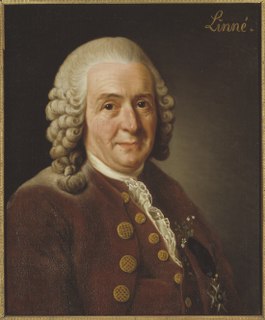 W
WCarl Linnaeus, also known after his ennoblement as Carl von Linné, was a Swedish botanist, zoologist, and physician who formalised binomial nomenclature, the modern system of naming organisms. He is known as the "father of modern taxonomy". Many of his writings were in Latin, and his name is rendered in Latin as Carolus Linnæus.
 W
WAmoenitates Academicae is the title of a multi-volume zoological and botanical publication consisting of the dissertations of the students of Carl Linnaeus, written during 1743–1776.
 W
WThe Apostles of Linnaeus were a group of students who carried out botanical and zoological expeditions throughout the world that were either devised or approved by botanist Carl Linnaeus. The expeditions took place during the latter half of the 18th century and the students were designated 'apostles' by Linnaeus.
 W
WThe bibliography of Carl Linnaeus includes academic works about botany, zoology, nomenclature and taxonomy written by the Swedish botanist Carl Linnaeus (1707–1778). Linnaeus laid the foundations for the modern scheme of binomial nomenclature and is known as the father of modern taxonomy. His most famous works is Systema Naturae which is considered as the starting point for zoological nomenclature together with Species Plantarum which is internationally accepted as the beginning of modern botanical nomenclature.
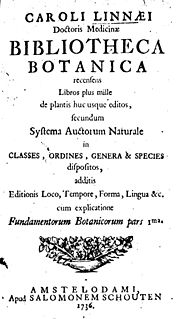 W
WBibliotheca Botanica is a botany book by Swedish naturalist Carl Linnaeus (1707–1778). The book was written and published in Amsterdam when Linnaeus was twenty-eight and dedicated to the botanist Johannes Burman (1707–1779). The first edition appeared in 1735 with the full title Bibliotheca Botanica recensens libros plus mille de plantis huc usque editos secundum systema auctorum naturale in classes, ordines, genera et species; it was an elaborate classification system for his catalogue of books.
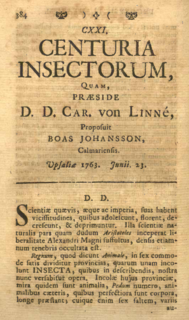 W
WCenturia Insectorum is a 1763 taxonomic work by Carl Linnaeus, and defended as a thesis by Boas Johansson; which of the two men should be credited with its authorship has been the subject of some controversy. It includes descriptions of 102 new insect and crustacean species that had been sent to Linnaeus from British America, Suriname, Java and other locations. Most of the new names included in Centuria Insectorum are still in use, although a few have been sunk into synonymy, and one was the result of a hoax: a common brimstone butterfly with spots painted on was described as the new "species" Papilio ecclipsis.
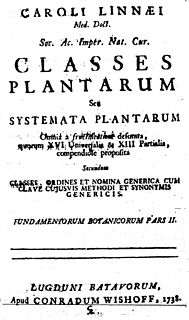 W
WClasses Plantarum is a book that was written by Carl Linnaeus, a Swedish botanist, physician, zoologist and naturalist.
 W
WGeorge Clifford III was a wealthy Dutch banker and one of the directors of the Dutch East India Company. He is known for his keen interest in plants and gardens. His estate Hartekamp had a rich variety of plants and he engaged the Swedish naturalist Carl von Linné, who stayed at his estate from 1736 to 1738, to write Hortus Cliffortianus (1737), a masterpiece of early botanical literature published in 1738, and for which Georg Dionysius Ehret did the illustrations. Many specimens from Clifford's garden were also studied by Linnaeus for his Species Plantarum (1753).
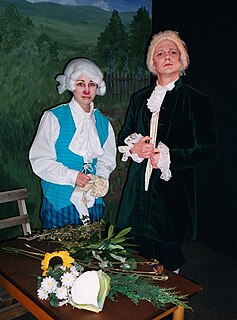 W
WCommemoration of Carl Linnaeus has been ongoing for over two centuries. Celebrated for his scientific work, Linnaeus was knighted and granted nobility in life. After his death, he has been featured in sculpture, on postage stamps and banknotes, as well as by a medal from the eponymous Linnean Society of London. Several notable people have the given names Linnaeus/Linné or Linnea/Linnéa. Among other things named in his honor are plants, astronomical features, towns, an arboretum, a mineral and a university.
 W
WCritica Botanica was written by Swedish botanist, physician, zoologist and naturalist Carl Linnaeus (1707–1778). The book was published in Germany when Linnaeus was twenty-nine with a discursus by the botanist Johannes Browallius (1707–1755), bishop of Åbo. The first and only edition was published in July 1737 under the full title Critica botanica in qua nomina plantarum generica, specifica & variantia examini subjiciuntur, selectoria confirmantur, indigna rejiciuntur; simulque doctrina circa denominationem plantarum traditur. Seu Fundamentorum botanicorum pars IV Accedit Johannis Browallii De necessitate historiae naturalis discursus.
 W
WThe Expedition to Lapland, the northernmost region in Sweden, by Carl Linnaeus in 1732 was an important part of his scientific career.
 W
WFauna Svecica was written by Swedish botanist, physician, zoologist and naturalist Carl Linnaeus (1707–1778).
 W
WFlora Lapponica is an account of the plants of Lapland written by botanist, zoologist and naturalist Carl Linnaeus (1707-1788) following his expedition to Lapland.
 W
WFlora Svecica was written by Swedish botanist, physician, zoologist and naturalist Carl Linnaeus (1707–1778).
 W
WFundamenta Botanica was one of the major works of the Swedish botanist, zoologist and physician Carl Linnaeus (1707–1778) and issued both as a separate work and part of the Bibliotheca Botanica.
 W
WGenera Plantarum is a publication of Swedish naturalist Carl Linnaeus (1707–1778). The first edition was issued in Leiden, 1737. The fifth edition served as a complementary volume to Species Plantarum (1753). Article 13 of the International Code of Nomenclature for algae, fungi, and plants states that "Generic names that appear in Linnaeus' Species Plantarum ed. 1 (1753) and ed. 2 (1762–63) are associated with the first subsequent description given under those names in Linnaeus' Genera Plantarum ed. 5 (1754) and ed. 6 (1764)." This defines the starting point for nomenclature of most groups of plants.
 W
WHartekamp, or Hartecamp, is the name of a villa in Heemstede, North Holland, the Netherlands, on the Bennebroek border. It was once the Buitenplaats of George Clifford, who employed Carl Linnaeus in 1737 to write his Hortus Cliffortianus, a detailed description of the gardens of Hartecamp.
 W
WThe Hortus Cliffortianus is a work of early botanical literature published in 1737.
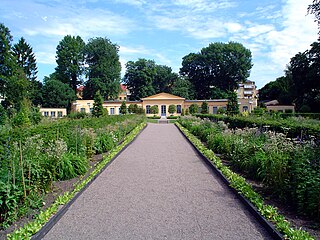 W
WThe Linnaean Garden or Linnaeus' Garden is the oldest of the botanical gardens belonging to Uppsala University in Sweden. It has been restored and is kept as an 18th-century botanical garden, according to the specifications of Carl Linnaeus.
 W
WThe Linnaeus Museum (Swedish:Linnémuseet) is a biographical museum in the Linnaean Garden in Uppsala, Sweden, dedicated to the 18th century botanist Carl Linnaeus. It is run by the Swedish Linnaeus Society. The house was built by Olaus Rudbeck in 1693 and served as official residence for employees at Uppsala University from the latter part of the 17th century until 1934. Its last occupant was musician Hugo Alfvén. Between 1743 and 1778, Carl Linnaeus resided in the building, and in 1937 it was re-made into a museum of Linnaeus personal and professional life. Furniture, household items and textiles, which belonged to the family, are exhibited together with Linnaeus personal medicinal cabinet, insect cabinet and herbarium.
 W
WCarl Linnaeus the Younger, Carolus Linnaeus the Younger or Carl von Linné d. y. was a Swedish naturalist. He is known as Linnaeus filius to distinguish him from his famous father, the systematist Carl Linnaeus (1707–78).
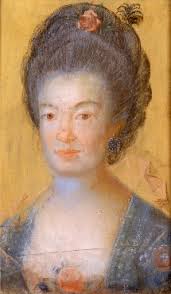 W
WElisabeth Christina von Linné (1743–1782), was a Swedish botanist, daughter of Carl von Linné and Sara Elisabeth Moræa.
 W
WThe Linnean Society of New South Wales promotes the Cultivation and Study of the Science of Natural History in all its Branches and was founded in Sydney, New South Wales (Australia) in 1874 and incorporated in 1884.
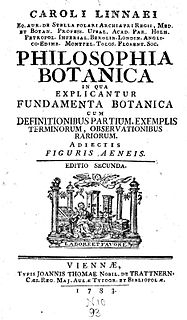 W
WPhilosophia Botanica was published by the Swedish naturalist and physician Carl Linnaeus (1707–1778) who greatly influenced the development of botanical taxonomy and systematics in the 18th and 19th centuries. It is "the first textbook of descriptive systematic botany and botanical Latin". It also contains Linnaeus's first published description of his binomial nomenclature.
 W
WRåshult is a village just north of Älmhult in Kronoberg County, Småland, Sweden. Råshult is the village where the Swedish scientist Carl Linnaeus was born in 1707.
 W
WSpecies Plantarum is a book by Carl Linnaeus, originally published in 1753, which lists every species of plant known at the time, classified into genera. It is the first work to consistently apply binomial names and was the starting point for the naming of plants.
 W
WSupplementum Plantarum Systematis Vegetabilium Editionis Decimae Tertiae, Generum Plantarum Editiones Sextae, et Specierum Plantarum Editionis Secundae, commonly abbreviated to Supplementum Plantarum Systematis Vegetabilium or just Supplementum Plantarum, and further abbreviated by botanists to Suppl. Pl., is a 1782 book by Carolus Linnaeus the Younger. Written entirely in Latin, it was intended as a supplement to the 1737 Genera Plantarum and the 1753 Species Plantarum, both written by the author's father, the "father of modern taxonomy", Carl Linnaeus.
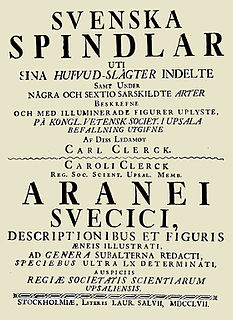 W
WThe book Svenska Spindlar or Aranei Svecici was one of the major works of the Swedish arachnologist and entomologist Carl Alexander Clerck and appeared in Stockholm in the year 1757. It was the first comprehensive book on the spiders of Sweden and one of the first regional monographs of a group of animals worldwide. The full title of the work was Svenska Spindlar uti sina hufvud-slägter indelte samt under några och sextio särskildte arter beskrefne och med illuminerade figurer uplyste – Aranei Svecici, descriptionibus et figuris æneis illustrati, ad genera subalterna redacti, speciebus ultra LX determinati, and included 162 pages of text and 6 colour plates. It was published in Swedish, with a Latin translation printed in a slightly smaller font below the Swedish text.
 W
WSystema Naturae is one of the major works of the Swedish botanist, zoologist and physician Carl Linnaeus (1707–1778) and introduced the Linnaean taxonomy. Although the system, now known as binomial nomenclature, was partially developed by the Bauhin brothers, Gaspard and Johann, 200 years earlier, Linnaeus was first to use it consistently throughout his book. The first edition was published in 1735. The full title of the 10th edition (1758), which was the most important one, was Systema naturæ per regna tria naturæ, secundum classes, ordines, genera, species, cum characteribus, differentiis, synonymis, locis or translated: "System of nature through the three kingdoms of nature, according to classes, orders, genera and species, with characters, differences, synonyms, places".
 W
WLinnaean taxonomy can mean either of two related concepts:the particular form of biological classification (taxonomy) set up by Carl Linnaeus, as set forth in his Systema Naturae (1735) and subsequent works. In the taxonomy of Linnaeus there are three kingdoms, divided into classes, and they, in turn, into orders, genera, and species, with an additional rank lower than species. a term for rank-based classification of organisms, in general. That is, taxonomy in the traditional sense of the word: rank-based scientific classification. This term is especially used as opposed to cladistic systematics, which groups organisms into clades. It is attributed to Linnaeus, although he neither invented the concept of ranked classification nor gave it its present form. In fact, it does not have an exact present form, as "Linnaean taxonomy" as such does not really exist: it is a collective (abstracting) term for what actually are several separate fields, which use similar approaches.